
Healing Through Connection: The Role of Animal Therapy
In the midst of trauma and upheaval, the Kyiv Zoo has stepped forward with a heartwarming and innovative initiative: an animal therapy program designed to help those affected by conflict. Launched shortly after the Russian invasion of Ukraine in February 2022, this program, known as The Good Phasmatidae, has positively impacted nearly 200,000 individuals including children, displaced families, and military personnel coping with the scars of war.
A Safe Haven for Healing
Olga Baratynska, the Zoo Program Manager, emphasizes the importance of creating a safe and calming environment for therapy. The program features a range of animals such as reptiles, birds, and insects, providing opportunities for guided interactions that promote emotional healing. For many participants, engaging with these animals serves as a gentle introduction to addressing the psychological impacts of their experiences, particularly in regions heavily affected by violence.
Bridging Human Connections in Times of Crisis
As ongoing hostilities continue to affect daily life, the staff at Kyiv Zoo have shown remarkable resilience. Despite losing 19 employees who have enlisted in the military, the dedication to animal and community welfare remains strong. Notably, collaborations with local hospitals are integral, allowing therapy sessions that both alleviate anxiety and serve as a bridge to mental health services for those who find traditional psychotherapy daunting.
Scientific Insight into Animal-Assisted Therapy
Research consistently highlights the profound effects of animal-assisted therapy on mental health. Interacting with animals has been shown to reduce stress and anxiety, making the Kyiv Zoo's initiative particularly valuable in a country grappling with the side effects of war. By facilitating these interactions, the zoo not only contributes to personal healing but also fosters community solidarity.
The Importance of Resilience and Hope
The story of the Kyiv Zoo and its therapy program encapsulates the essence of resilience. In a context where many face uncertainty and despair, the presence of compassion—embodied by both animals and humans—offers a beacon of hope. As participants undergo this transformative experience, they also learn that healing is possible, even in the darkest of times.
Communities are often at the heart of healing; the Kyiv Zoo exemplifies this by bringing together people in shared moments of care and connection with animals. As they continue their vital work, the message is clear: even amid chaos, initiatives grounded in love and empathy can forge paths to recovery.
 Add Row
Add Row  Add
Add 




Write A Comment